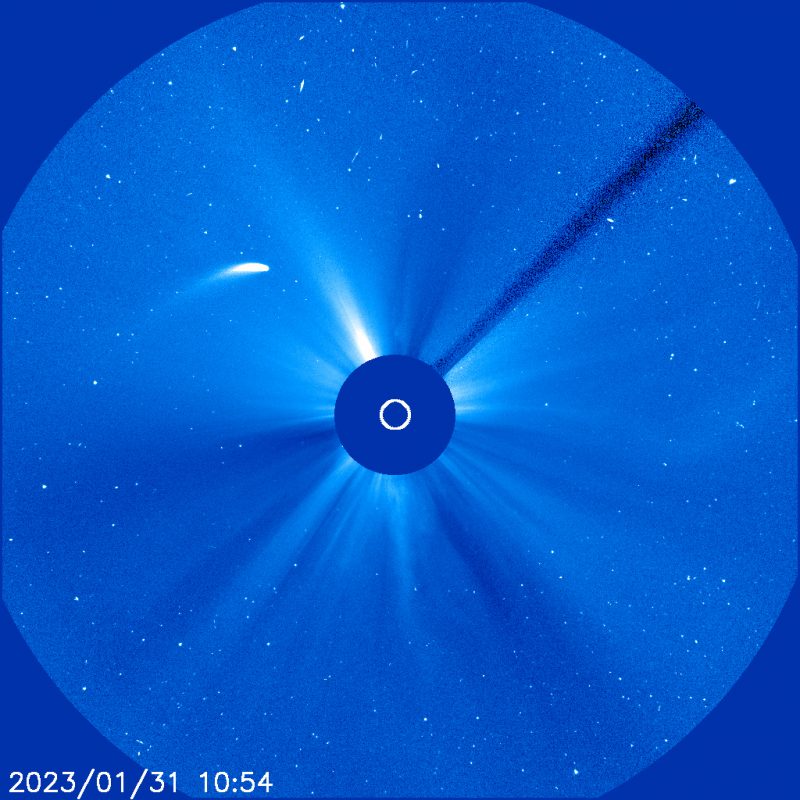
Don Machholz, a beloved member of the EarthSky team until his passing in 2022, discovered 12 comets that bear his name. One of those, Comet 96P/Machholz, reached its perihelion, or closest point to the sun, today (January 31, 2023).
As it neared the sun, fragments of the comet broke off. And some of us feared that – like many other comets near the sun – it might entirely disintegrate! But it didn’t. The most recent image (above) shows that it survived closest approach mostly intact.
So far FOUR tiny fragments of 96P have been reported by citizen scientists! We've seen 96P fragments in the past, but only 1 or 2 at a time. And the timing of these fragments doesn't match previous fragments, so maybe these are new fragments, or fragments of fragments, or…????? pic.twitter.com/LJPbbmacdb
— Karl Battams (@SungrazerComets) January 30, 2023
Comet 96P has now passed perihelion, and is looking great! ?
Follow along on the @MissionSoho website: https://t.co/1iYjLF4Kny (but note my many recent caveats about how the "pretty picture" rate has been slowed in favor of science data) pic.twitter.com/l00r7LR0AH
— Karl Battams (@SungrazerComets) January 31, 2023
Comet Machholz is unusual
Comet 96P/Machholz is a short-period comet with some unusual characteristics. Its 5.29-year orbit around the sun brings it closer to the sun than any other known short-period comet. Its orbit is also quite eccentric and tilted in relation to other objects in the solar system. Plus, the comet contains very little carbon and cyanogen, which may point to extrasolar origins.
Visit Don Machholz’ tribute page at EarthSky
The comet’s fragmented history
Karl Battams (@sungrazercomets on Twitter) is an astrophysicist and computational scientist based at the Naval Research Laboratory in Washington DC. He talked to EarthSky about Comet 96P/Machholz. He’s been following its return, as it reached perihelion, its closest point to the sun this month. He told EarthSky:
This is the 6th passage of 96P/Machholz through the field of view of our LASCO cameras [on NASA’s SOHO sun-observing spacecraft]. It’s a particularly intriguing comet for a number of reasons. Ground-based observations have shown it to have a very unusual composition when compared to other short-period comets.
It is also apparently very prone to fragmenting and has a long and complicated history of doing so. In recent years, we’ve started seeing a number of tiny fragments many hours ahead of the parent nucleus, indicating that this fragmenting is a process occurring regularly.
Karl told us that scientists believe Comet 96P/Machholz’s fragmenting is the source for other comets. He said:
Historically, we believe it has also released large numbers of fragments, as the two SOHO-observed families of comets known as the Marsden and Kracht group are both thought to be related to 96P.
It’s also the parent of a number of Earth-encountering meteor showers, including the Quadrantids and Arietids.
Studying Comet 96P/Machholz at perihelion
Karl explained what scientists are looking for now, during the comet’s 2023 perihelion:
For this latest passage through the LASCO field of view, we’re taking advantage of the few color filters that LASCO has on board to allow us to look at slightly different wavelengths of light.
We hope to use these observations to learn a little more about the amount of dust that 96P is producing, and some of the emission that might be coming from the material it is releasing.
The near-sun environment is extremely hostile to icy bodies like comets, so these perihelion passages are the time when some of the most interesting activity happens.
Bottom line: Comet 96P/Machholz made its closest approach to the sun on January 31, 2023. This unusual comet left behind tiny fragments.











